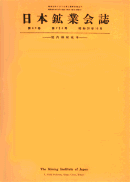巻号一覧

後続誌
前身誌
71 巻, 802 号
選択された号の論文の6件中1~6を表示しています
- |<
- <
- 1
- >
- >|
-
平松 良雄, 藤中 雄三, 段野 勝, 寺田 孚1955 年 71 巻 802 号 p. 167-171
発行日: 1955/04/25
公開日: 2011/07/13
ジャーナル フリーThis paper gives, in the first place, the details in construction of an apparatus to solve ventilation network problemes experimentally, on a principle which was previously originated by one of the authors. Secondly network problems are classified into four kinds and it is pointed out that they are not always soluble by this apparatus because it is based not on a direct solution but on a kind of successive approximation, and that various kinds of problems are yet to be soluble by it in ways described in this paper.抄録全体を表示PDF形式でダウンロード (3734K) -
和田 正美, 平野 仁士, 本間 寅二郎1955 年 71 巻 802 号 p. 173-179
発行日: 1955/04/25
公開日: 2011/07/13
ジャーナル フリーAmong various technical problems related to the operation of densemedia seperation of ores and coals, the most fundamental ones are the viscosity and stability of heavy suspensions and the physical characteristics of the material for suspensions.
The viscosity. of suspensions has been studied by many investigators and it has been established that Einstein's equation is applicable for lower concentrations and Arrhenius' empirical formula for concentrations up to 20-25%. However, the higher concentrations, in which these equations fail to be applied, are used in practice. Moreover, it is to be teken into consideration that the viscosity of suspensions is influenced by the size and shape of suspensoid. particles. It is reported elsewhere that the viscosity is also affected by the specific gravity of particles.
In this report the viscosity of heavy suspensions has been studied critically and the following empirical viscosity equation applicable for higher concentrations has been introduced. η=ηw[1+K{δ-1+p (σ/D) k} C+qen1δ (δ/D) n2 (δ-1+σ/D)nCn] where η=viscosity of suspensions, cp.ηω; =viscosity of water, cp.; C=concentration in volume, %;δspecific gravity of suspensoid particles;σ-=mean diameter of suspensoid particles, μ; D=diameter of the capillary, μ; e=base of Naperian logarithm; and K, p, k, q, n1, n2and n=constants. In this equation the variables such as the concentration and the size and the specific gravity of suspensoid particles are involved. From this equation the viscosity of suspensions of any concentration and of suspensoid particles of any size and specific gravity may be calculated. The exception is the viscosity of suspensions of the mixture of two or more materials or of the mixed size particles. The materials used are copper slag, “Sendust”, magnetite, iron sand, etc. and the consistometer used is similar to that of De Vaney and Shelton but with some modifications such as preagitation and temperature control of suspensions.抄録全体を表示PDF形式でダウンロード (3192K) -
藤井 雄二郎1955 年 71 巻 802 号 p. 181-185
発行日: 1955/04/25
公開日: 2011/07/13
ジャーナル フリーThe surface tension of aqueous terpene solutions was measured by the maximum bubble pressure method. The results obtained were as follows:
(1) The surface tension of aqueous terpene solutions was varied by Szyszkowski's equation and the constants in the equation were determined.
(2) The decrease in surface tension of aliphatic terpenes was greater than that of monocyclic or bicyclic terpenes.
(3) Providing that the surface tension of the component aqueous solution varies inaccordance with Szyszkowski's equation and that there are no mutual interferences among the componetns of the mixture, the theoretical expression of the relationship between the surface tension of the mixed solution and the concentration of the solute was proposed as follows:γ=γ0IIi {-Cilog (1+ci/ai)} where γ0 and γ denote the surface tension of water and of the mixed solution, ci is the concentration of the solute, and Ci and ai are constants found in Szyszkowski's equation.
(4) It was shown that the surface tension measured on the mixture of the terpene solutions was in satisfactory agreement with that calculated from the above equation.抄録全体を表示PDF形式でダウンロード (1012K) -
珪酸飽和のFeO-SiO2緩と平衡する皮へのFeOの溶解矢沢 彬, 亀田 満雄1955 年 71 巻 802 号 p. 187-190
発行日: 1955/04/25
公開日: 2011/07/13
ジャーナル フリーIn order to determine the solubility of FeO in Cu2S-FeS mattes coexisting with the Si02-saturated FeO-Si02 slag, briquetts of powdered mixture of Cu2S, FeS and somewhat excess FeO were melted in silica crucibles at temperatures of 1, 200, 1, 250 and 1, 300°C. The components of matte were calculated from the analytical values obtained, and the solubility of FeO was determined as is shown in Fig. 1. Although the FeS-matte containing no Cu2S dissolves 27.5 pct FeO, the content of dissolved FeO decreases as the matte grade increases, and reaches substantially down to zero for the Cu2S-matte. The solubility of FeO is practically unaffected by the change in temperature, or by the addition of lime or alumina. The contents of S in the mattes in this case are found between 26.5 and 20 pct as are shown in Fig. 3, and in general these are considerably smaller than those in the matte composed merely of Cu2S and FeS, especially in the mattes of the lower grade. The decrease in S content with increasing Cu2S content is comparatively slight as far as the grade of matte is low. Such general trend of the change in S content is analogous to that encountered in practice, and hence considerable contents of FeO are expected to be soluble in actual mattes. In fact, the microscopic examination revealed the dissolution of FeO in actual mattes. Moreover, the presumed FeO content was calculated from the data in practice, and the same general trend with the results obtained in the present investigation could be recognized.抄録全体を表示PDF形式でダウンロード (3925K) -
大山 正, 下飯坂 潤三, 八嶋 三郎1955 年 71 巻 802 号 p. 191-194
発行日: 1955/04/25
公開日: 2011/09/13
ジャーナル フリーPDF形式でダウンロード (730K) -
1955 年 71 巻 802 号 p. 195-216
発行日: 1955/04/25
公開日: 2011/07/13
ジャーナル フリーPDF形式でダウンロード (9235K)
- |<
- <
- 1
- >
- >|